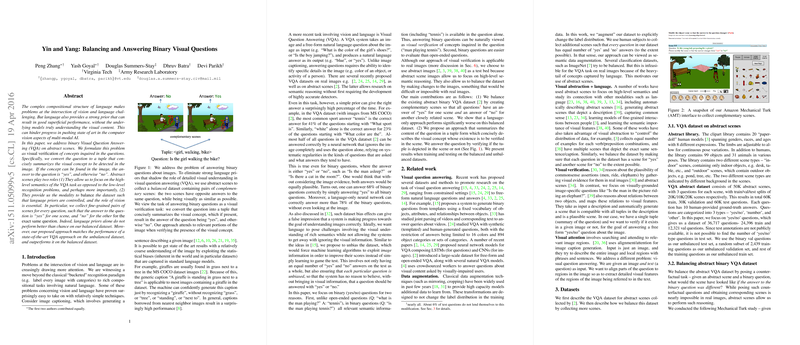Analyzing "Yin and Yang: Balancing and Answering Binary Visual Questions"
In "Yin and Yang: Balancing and Answering Binary Visual Questions," Zhang et al. delve into the intricacies of binary Visual Question Answering (VQA) within the context of abstract scenes. This paper addresses the challenge of disentangling the visual understanding from language biases in multi-modal AI systems, aiming to elevate the role of vision in visual question-answering tasks by tightly controlling language priors.
Problem Scope and Contribution
Zhang et al. tackle the core issue of language priors overshadowing visual comprehension in VQA tasks. These language biases can lead to relatively strong performance without genuine visual understanding, as simple LLMs can exploit statistical correlations in datasets. For instance, in existing VQA datasets, common responses like "tennis" or "white" can often answer a high percentage of relevant questions. The authors employ a novel approach by focusing on binary questions, reducing the problem to validating the presence of queried visual concepts within images.
A key contribution of the paper is the balancing of VQA datasets through the generation of complementary abstract scenes for each question. This approach involves creating pairs of scenes with minimal variations, such that a given binary question yields opposite answers (yes/no) for each scene in the pair. This semantic data augmentation ensures a more reliable assessment of visual comprehension by eliminating the influence of language biases and highlighting the necessity for detailed visual reasoning.
Methodology and Technical Approach
The methodology involves two main components: converting a question into a concept tuple and subsequently verifying this concept within an image. The tuple, which summarizes the primary object (P), relation (R), and secondary object (S), distills the semantic core of the question. For example, the query "Is the cat on the chair?" translates to the tuple (cat, on, chair). The model then aligns these text-based tuples with visual features, relying on mutual information to associate language components to image segments.
The authors introduce an ensemble model comprising two pathways: a Q-model utilizing LSTM-generated language features and a Tuple-model leveraging word2vec embeddings for tuples. These language features are mapped to a shared representation space with visual features capturing object and scene semantics, enabling sophisticated visual verification tasks.
Evaluation and Results
Experimental results underscore the merit of the balanced dataset strategy. Models trained on these balanced distributions are better at leveraging visual input, achieving performance gains when tested on the balanced dataset. The proposed approach (Q+Tuple+A-IMG)—which emphasizes attention to specific image regions—demonstrates superior performance over state-of-the-art VQA models that rely on holistic image features (Q+Tuple+H-IMG). Crucially, the improvements manifest more prominently in settings where the dataset biases are mitigated, underscoring the efficacy of language-vision disentanglement.
Implications and Future Directions
The research presented indicates significant implications for the design of VQA systems. By curating datasets to minimize language biases, the research outlines a viable pathway to developing AI systems that genuinely understand and interpret visual stimuli rather than gaming statistical regularities in language. This foundational work encourages further exploration into more balanced real-world datasets and prompts the examination of fine-grained semantic understanding in more complex visual environments.
Future work could profitably extend these findings by addressing challenges of dataset balancing in real images, potentially exploring hybrid datasets combining synthetic and natural scenes. Moreover, refining tuple extraction and alignment processes with more sophisticated LLMs could further improve understanding and performance in diverse VQA tasks.
In summation, the paper by Zhang et al. presents a cogent strategy for reinforcing the visual component in VQA systems, offering robust insights into dataset design and AI interpretability, with a focus on achieving nuanced visual comprehension.
